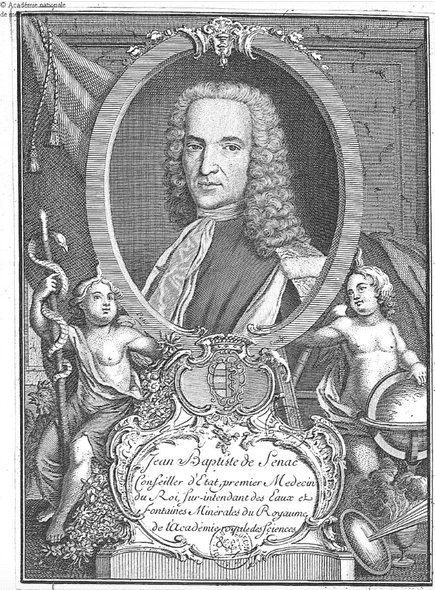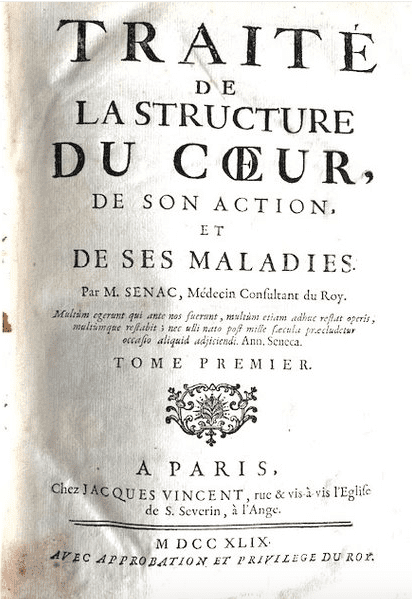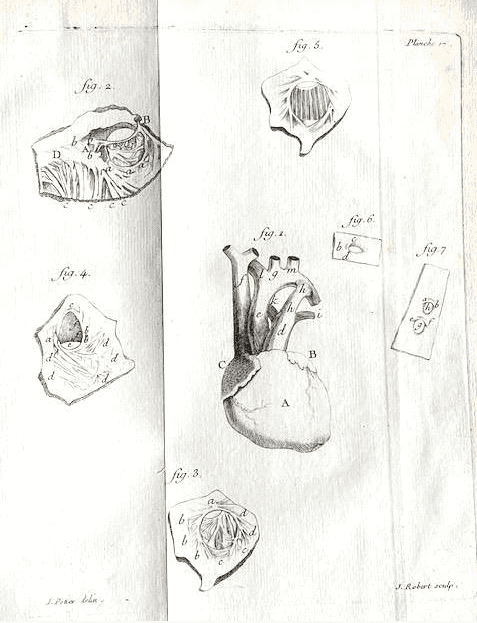Göran Wettrell
Lund, Sweden

William Harvey was an important figure in the early days of cardiovascular physiology. Based on meticulous observations, he published De Motu Cordis and Sanguinus in 1628 and has been proposed as the founder of physiology and cardiology.1 During the late seventeenth and early eighteenth centuries, physicians such as Raymond Vieussens (1641-1715), Giovanni-Maria Lancisi (1654-1720), and Richard Lower (1631-1691) studied and verified earlier findings in cardiac anatomy and physiology. Their work, along with the observations of the eminent William Harvey, paved the way for Jean-Baptiste de Sénac (1693-1770) to expand work in cardiac pathology, circulatory physiology, and early clinical cardiology (Figure 1).
His reputation within these fields was established in 1749, when he published his monumental work Traitié de la Structure du Coeur, de son Action et de ses Maladies (Figure 2), a treatise that systematically addressed the structure and function of the heart.2 It covered all that was known in the cardiovascular field at that time. His own research and observations on the anatomy of the heart were included, based on decades of post-mortem examinations. He claimed that the truth about diseases could be found through autopsies and that “the dead served as a book of true learning.”3 The publication has been referred to as the first comprehensive Western textbook on cardiology.4 The text influenced the practice of cardiology during the eighteenth century. The field evolved further through the work of French physicians such as Jean-Nicolas Corvisart (1755-1821) and his pupil Rene T.H. Laennec (1781-1826), who advanced knowledge of pathological anatomy and clinical findings.
Jean-Baptiste de Sénac and his life

Sénac was born in 1693 in the commune of Lombez, Gascony, France. His father was a lawyer. His parents were Protestants, but Sénac studied religion at a Jesuit college. He continued his studies in medicine in Leiden and later in London. In 1721, he married the daughter of a merchant. They brought up three children and his younger son, Gabriel Sénac de Meilhan, became a well-known novelist and historian. He practiced medicine in Montpellier and Rheims before coming to Paris in 1723, where he was elected an associate member of the Royal Academy of Sciences. That year he translated the book A new course of chemistry following the principles of a Newton and Stahl. Another book, Compendium Anatomicum, written in Latin and published in 1717 by the German surgeon Lorentz Heister, was translated into French with some new comments by Sénac. This well-known work established Sénac as a respected anatomist. During the next two decades he continued, mostly anonymously, to communicate on diverse subjects such as the anatomy of the respiratory organs, drowning, the diaphragm, bloodletting, the plague, and intermittent fever.
Sénac moved to Versailles in 1733 to be a physician at the Royal Hospital of Versailles. He also served as a doctor in the Flandern Army under Marshal Maurice de Saxe. In 1752 he became the chief and personal physician to Louis XV and was appointed counsellor of the state and superintendent of mineral waters and medicinals in France. Sénac died in December, 1770 at the age of seventy-seven.5
Traitè de la Structure du Coeur, the first textbook on cardiology

Sénac’s fame in the history of cardiology is based on his Traite de la Structure du Coeur published in 1749, when he was fifty-six years old. The treatise consisted of four books in two volumes, 1200 pages in total.2 The text synthesized the contemporary knowledge of anatomical, physiological, and pathological cardiac issues and was supplemented by seventeen delicately engraved plates. The detailed engravings by Mr. J. Robert were based on drawings by J. Potier, an infantry captain and engineer. A second edition of the book appeared in 1774 after Sénac’s death and further editions were published in 1777 and 1783.
Book One, titled De la Structure du Coeur, provided a detailed review of the anatomy of the heart. The text referred to the work of earlier investigators with an emphasis on Harvey, Lower, Vieussens, and Lancisi. The detailed anatomical text focused on the pericardium, ventricles and atria, valves, coronary arteries, cardiac nerves, and development and structure of the fetal heart.3 The different sections were supplemented by excellent engraved folding plates. In Chapter IX, titled Nouvelle Description du Coeur, Sénac presented his own investigation of the muscle fibers of the myocardium, supported with four detailed engraved plates (Figure 3). He suggested the concept of separate ventricular layers, emphazing the helical arrangement of the inner and outer muscular coats but observing that the left ventricle possessed a middle layer of circular fibers.6
Book Two, entitled L’usage and l’action du Coeur, presented function and physiology of the heart. Sénac again referred to previous investigators in his discussion of bloodflow through the heart, the force and contraction of the heart, and dilatation. He also focused on fetal circulation of the heart with specific reference to William Harvey (Figure 5).
Book Three, entitled De la Circulation du Sang, reviewed blood circulation starting with ancient masters such as Hippocrates and Galen, and then the findings of William Harvey. Sénac discussed the formation of blood, the pulmonary circulation, and a detailed description of the examination and variation of pulses. Clinical diagnosis of heart disease at this time was done by checking pulses and direct auscultation of the chest.

Book Four, with the title Des maladies du Coeur, discussed different causes that influence cardiac activity. Sénac proposed that “the nature of the blood influences the movement of heart during disease.” He considered that “obstruction increases the force of the heart through irritation” but may also induce dilatation of the ventricles, and that “the quantity of blood augments or reduces the force of the heart.” Among the more common cardiovascular problems discussed are dilatations and aneurysms. Sénac found that dilatation of the right atrium was more frequent than that of the left, and dilatation of the atria seemed more common than that of the ventricles.2,3 The symptoms of heart dilatation and congestive heart failure at that time were treated with opium. He also reported on “ossification” of the valves in the left ventricle, including the semilunar valves. Later, in the Supplement, he commented on dilatations or aneurysms in the aorta (Figure 4).
Two chapters (V and VI) were devoted to diseases of the pericardium. Sénac discussed, based on case reports, findings related to fluid within the pericardium and how it influenced respiration. He mentioned the diagnostic difficulties of hydropericardium, but also the possibility of performing a puncture to drain it.
The issue of heart polyps had been of great interest since the sixteenth century. Sénac devoted chapter X to heart polyps and their cause, structure, and effects such as syncope. Influenced by Malpighi, Sénac concluded that certain types of polyps and blood clots were formed after death, but others might have their origins in blood vessels and correlate with “asthma,” (likely referring to heart failure), which could have deleterious effects during a person’s lifetime.

For centuries, palpitations were commonly associated with diseases of the heart. An entire chapter (XI) of Book Four was devoted to palpitations, with beats described as active, lively, irregular, and of ectopic origin.7 Sénac’s observations that irregular beats of the heart were correlated with autopsy findings of mitral valve disease and an enlarged atrium and ventricle were important contributions to the history of atrial fibrillation.4 He recommended treating “rebellious palpitation” with digestive aids, cordials, and pain relief. He found the use of “quinquina,” – cinchona or Peruvian bark – mixed with a little rhubarb and, if needed, an additional “light purgative” to be helpful for palpitations.2 The choice of quinine was an important contribution as therapy for cardiac arrhythmias and is still in use today. He also proposed treatment with opium and electricity. On the other hand, Sénac emphasized that palpitations occurring because of fever, physical activity, or mental agitation are not illnesses and do not cause damage.2,4
In the final chapter (XII) of Book Four, Sénac wrote about syncope. Many serious diseases of the heart presented in the treatise may cause palpitations and syncope. Other reasons for syncope are mentioned, such as epileptic, hysteric, and ecstatic. The treatments proposed were diverse and included aromatics and stimulants. Specific remedies were suggested, such as “lilium convallium,” or lily of the valley, which contains cardiac glycosides, as well as tincture of opium (Laudanum or Philonium).2
The Supplement contained descriptions of different parts of the heart and other organs rendered by previous and contemporary anatomists. Sénac reviewed the anatomy of the coronary arteries, reported on microscopical investigation of blood, and discussed the anatomy of the Eustachian valve and the foramen ovale in fetal circulation (Figure 5).
Sénac and his extended and critical analysis
Sénac’s treatise was the first systematic textbook on cardiology that embraced the anatomy, physiology, and pathology of the heart. His understanding, as expressed in the treatise, was based on his own clinical observations combined with critical analysis of available writings. Jean-Nicolas Corvisart, the French physician and pioneer of clinical cardiology, admired Sénac’s accomplishments in describing pathological anatomy. The work remained popular until the beginning of the nineteenth century.
References
- Snellen, HA. History of Cardiology. Rotterdam: Donker Academic Publications. 1984, p. 9.
- de Sénac, JB. Traité de la structure dui Coeur, de son Action et de ses Maladies. 1st edition, two volumes. Paris, Jacques Vincent. 1749.
- Bowman, IA. Jean-Baptiste Sénac and his Treatise on the Heart. Texas Heart Institute Journal. 1987; 14: 5-11.
- McMichael, J. History of atrial fibrillation 1628-1819: Harvey – de Sénac – Laennec. Br Heart J. 1982; 48: 193-7.
- Karamanou, M, et al. Jean-Baptiste de Sénac’s (1693-1770) important work on cardiology and valvular disorders. Current Pharmaceutical Design. 2016; 22: 1853-56.
- Andersson, RH, et al. The anatomical arrangement of the myocardial cells making up the ventricular mass. European Journal of Cardio-thoracic Surgery. 2005; 28: 517-25.
- Wooley, CF. Jean-Baptiste de Sénac. Clin. Cardiology. 1995; 18: 741-2.
GÖRAN WETTRELL, MD, PhD, FLS, is an associate professor and senior consultant in pediatric cardiology and pediatrics at Lund University, Sweden with a focus on cardiac molecular genetics and primary arrhythmias. Other interests include male choir singing, travel, and medical history.
Highlighted in Frontispiece Volume 14, Issue 3 – Summer 2022

Leave a Reply